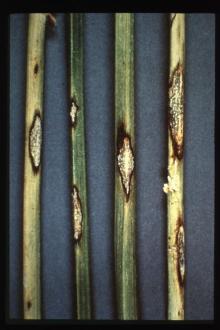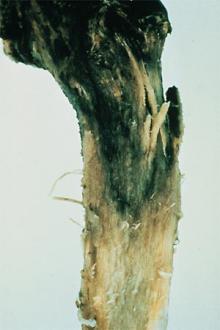Cause Colletotrichum trifolii, a fungus favored by wet conditions, spreads rapidly during warm, humid weather. Potentially other Colletotrichum spp. can be pathogenic. The fungus can survive in infected plant debris in the field or on equipment. Spores can be spread on contaminated seed.
Symptoms Symptoms on resistant plants are a few small, irregularly shaped, blackened areas on stems; susceptible plants exhibit large, sunken oval to diamond-shape lesions on stems. Large lesions are straw-color with brown borders and small black fruiting structures (acervuli) may develop in the center of spots. Straw-color shoots, which may have a shepherd's crook, can be observed throughout the field in summer or fall. Crowns can be infected, characterized by a bluish black rot of the crown. Affected plants may be killed directly or predisposed to winter injury.
Cultural control
- Plant resistant varieties.
- Remove infested plant debris from equipment.
Chemical control
- Priaxor Xemium (Group 7 + 11) at 4 to 6.9 fl oz/A on 14- to 21-day intervals. Do not make more than 2 applications per cutting or 3 applications per year. Preharvest interval is 14 days. 12-hr reentry.
- Quadris Flowable (Group 11) at 6 to 15.5 fl oz/A on 14-day intervals. Do not apply more than 15.5 fl oz/A per cutting. Preharvest interval is 14 days for grazing or harvest for forage and hay. 4-hr reentry.
- Vacres (potassium bicarbonate) at 2.5 to 5 lb/A on 7- to 14-day intervals. Preharvest interval is zero (0) days. 4-hr reentry.



